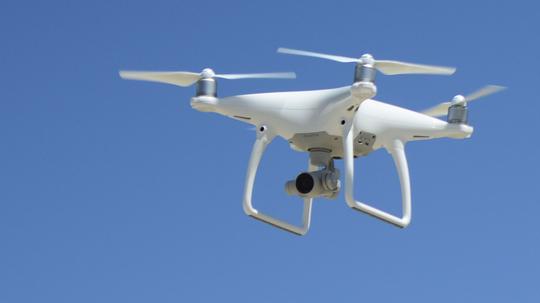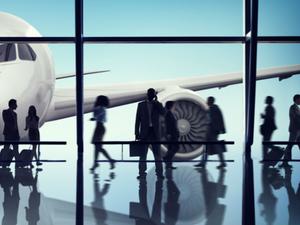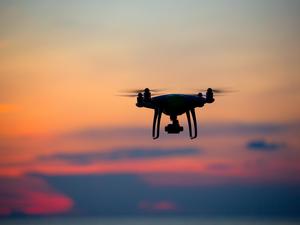
It is no longer uncommon to see drones at events or to imagine a world where they are used to deliver packages directly to the doorstep. And during the pandemic, which has raised concerns about global supply chains while increasing the demand for contactless, on-demand delivery, their use in last-mile logistics is likely to accelerate, according to a group of UT Dallas researchers.
But what does a city look like when drone deliveries zipping overhead are as common as on-demand service vehicles are now? And what does that mean for retailers and the customers they serve?
In a recently published article called “Retail Deliveries by Drones: How Will Logistics Networks Change” published in Production and Operations Management, UT Dallas researchers Milind Dawande, Ganesh Janakiraman and Vijay Mookerjee offer an idea of what the future of drone delivery will look like.
“I’m thinking about this current time and by that I mean the current pandemic. I think customers are putting, for valid reasons, a lot of value on delivery safety during these times, in addition to delivery speed,” Dawande, a professor of operations management at UT Dallas’ Naveen Jindal School of Management, told NTX Inno. “Hands-free, doorstep delivery that drones offer I think is of great value during the current time and therefore I feel that to some extent we might see strong pilots being conducted… in metro areas as early as this holiday season.”
Some of the most recent news in drone delivery systems came with the FAA’s approval to allow Amazon to operate as a drone airline, delivering packages to customers with the technology. As the company and other like it continue to advance drones capabilities and integrate them into last mile supply chain networks, which Dawande said is often the most expensive leg for retailers, one of the most noticeable impact for consumers will be the decreased delivery times.
He said for retailers this would like lead to an expansion in the impulse buying market, as customers can receive their packages in what Dawande said could be between five to 30 minutes. Dawande notes that increasingly competition in the retail space has shifted from prices to delivery times. And since it is something that consumers are coming to expect, profit margins have been driven down, as the cost to maintain inventory and speed for quick deliveries increases.
“Drone technology can really lead to demand expansion. The impulse buy will increase; there will be more demand created by customers because of drone deliveries. That demand is not being exploited right now.” Dawande said.

The way Dawande and the other researchers see shaping the way retailers operate is by moving to a more decentralized network for delivery, with drones at the core. Recently, Amazon and other e-commerce retailers have been snagging up warehouse space around North Texas, hiring thousands across the state. It’s a trend Dawande said he sees increasing, with companies managing many small facilities that can reach customers more quickly with delivery drones than having one large distribution center.
In order to manage these drone networks, Dawande said companies would likely partition delivery time zones around their distribution sites, allowing them to create guaranteed and customizable delivery time offerings.
“With a limited number of zones, the retailer should be able to capture most of the profits it would from perfect customization,” Dawande said.
As large companies build out their drone capabilities and delivery networks, smaller businesses operating in the space could fall behind technology. However, Dawande said he doesn’t see that meaning small business losing more customers. He said the larger businesses like Amazon that are capable of rapidly building and scaling their capabilities will likely start offering drone services in a similar way it offers cloud services through AWS.
“They will figure it out first, they will solve all the technical and other problems and they will become experts on drone travel, but then they might offer drone-as-a-service,” Dawande said.
There are still issues to be worked out with drone delivery systems, the researchers note. In dense urban areas, where leasing or developing new distribution space is unavailable or cost prohibitive, it could be difficult to create the decentralized network of facilities needed. However, Dawande said this is something that could be overcome by some retailers who operate physical store space that could eventually act as distribution hubs as technology advances. He said in some areas, a network of human freight shipping and drones could also help overcome the hurdle.
That also solves another issue that comes up with many emerging technologies – their effect on jobs in the industry. Dawande said that while certain positions are likely to be affected, like drivers, as they are replaced by drones, other positions will be created around maintaining and monitoring the drones. He added that with more, smaller distribution sites, additional packagers might be needed to keep up with demand.
“Like any automation technology, there will be some erosion of conventional jobs but new jobs will also be created, and those probably will be higher paying jobs,” Dawande said.
One of the other issues that surround drone use in logistics and beyond is privacy. More drones moving quickly overhead to deliver a package to a specific doorstep will require video and other tracking technology to help navigate buildings, trees and powerlines. And that technology will inevitably record video data of private property.
The issue is being worked on by the North Central Texas Council of Governments and other state and federal organizations, as they looks to help bolster unmanned flying technology development in the region. Dawande said there will likely need to be a tradeoff for the loss of some privacy, potentially in the form of some public service provided by the companies like free health care related deliveries. He added that data collected during delivery shouldn’t be stored and saved by the companies operating the networks.
“If drone deliveries are done right, I think that consumers will become even more loyal to the companies that they order from,” Dawande said.






